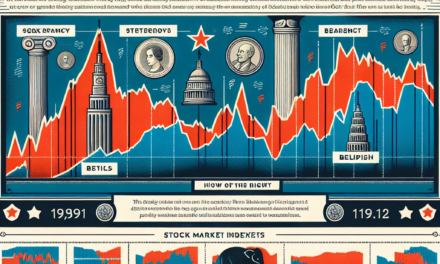“Novo Nordisk Shares Tumble: 2025 Outlook Casts Shadow on Growth Prospects”
Introduction
Novo Nordisk, a leading global healthcare company known for its innovative diabetes care solutions, recently experienced a significant decline in its stock value, reaching a nine-month low. This downturn was triggered by the company’s release of a disappointing financial outlook for 2025, which fell short of market expectations. Investors reacted swiftly to the news, expressing concerns over the company’s future growth prospects and its ability to maintain its competitive edge in the rapidly evolving pharmaceutical industry. The unexpected forecast has prompted analysts and stakeholders to reassess Novo Nordisk’s strategic direction and its potential impact on long-term profitability.
Impact Of Novo Nordisk’s 2025 Outlook On Investor Confidence
Novo Nordisk, a global leader in diabetes care and hormone replacement therapies, recently experienced a significant decline in its stock value, reaching a nine-month low. This downturn was primarily triggered by the company’s disappointing financial outlook for 2025, which has raised concerns among investors and analysts alike. The Danish pharmaceutical giant, known for its innovative treatments and robust market presence, has long been a favorite among investors seeking stability and growth. However, the recent projections have cast a shadow over its future prospects, leading to a reevaluation of investor confidence.
The company’s revised outlook for 2025 suggests a slower growth trajectory than previously anticipated. This has been attributed to several factors, including increased competition in the diabetes care market, potential pricing pressures, and the challenges of expanding into new therapeutic areas. As a result, investors are now questioning whether Novo Nordisk can maintain its competitive edge and continue to deliver the strong financial performance that has characterized its past.
One of the primary concerns is the intensifying competition in the diabetes care sector. With numerous pharmaceutical companies vying for market share, Novo Nordisk faces the challenge of differentiating its products and maintaining its leadership position. The emergence of biosimilars and new entrants offering innovative solutions has further complicated the landscape, potentially eroding Novo Nordisk’s market dominance. Consequently, investors are wary of the company’s ability to sustain its growth in such a competitive environment.
Moreover, pricing pressures have become a significant concern for the pharmaceutical industry as a whole, and Novo Nordisk is no exception. Governments and healthcare providers worldwide are increasingly scrutinizing drug prices, seeking to reduce healthcare costs. This trend poses a risk to Novo Nordisk’s profitability, as the company may be forced to lower prices or offer discounts to remain competitive. Such measures could impact its revenue growth and, in turn, investor confidence.
In addition to these challenges, Novo Nordisk’s efforts to diversify its portfolio and expand into new therapeutic areas have not yet yielded the expected results. While the company has made strategic investments in areas such as obesity treatment and cardiovascular disease, these initiatives are still in their early stages. The uncertainty surrounding the success of these ventures adds another layer of complexity to the company’s future outlook, leaving investors cautious about its long-term growth potential.
Despite these challenges, it is important to note that Novo Nordisk remains a formidable player in the pharmaceutical industry. The company has a strong track record of innovation and a robust pipeline of products in development. However, the current market dynamics and the revised 2025 outlook have undoubtedly shaken investor confidence, prompting a reassessment of the company’s valuation.
In conclusion, the recent decline in Novo Nordisk’s share price reflects the growing concerns among investors regarding the company’s future growth prospects. The combination of increased competition, pricing pressures, and the uncertainty surrounding its diversification efforts has led to a more cautious outlook. While Novo Nordisk continues to be a key player in the pharmaceutical industry, it must address these challenges effectively to restore investor confidence and ensure sustainable growth in the years to come. As the company navigates this complex landscape, its ability to adapt and innovate will be crucial in regaining the trust of its investors and maintaining its position as a leader in the global healthcare market.
Analyzing The Factors Behind Novo Nordisk’s Share Price Decline
Novo Nordisk, a global leader in diabetes care and a prominent player in the pharmaceutical industry, has recently experienced a significant decline in its share price, reaching a nine-month low. This downturn has been primarily attributed to the company’s disappointing outlook for 2025, which has raised concerns among investors and analysts alike. To understand the factors contributing to this decline, it is essential to examine the broader context of the pharmaceutical market, the company’s strategic decisions, and the specific challenges it faces.
Firstly, the pharmaceutical industry is characterized by intense competition and rapid innovation, which can significantly impact a company’s market position. Novo Nordisk, despite its strong reputation and established product portfolio, is not immune to these pressures. The company’s recent forecast for 2025, which fell short of market expectations, has been a critical factor in the decline of its share price. Investors had anticipated more robust growth projections, particularly given the increasing global prevalence of diabetes and the corresponding demand for effective treatments. However, the company’s cautious outlook has led to concerns about its ability to maintain its competitive edge in an evolving market.
Moreover, Novo Nordisk’s strategic decisions have also played a role in shaping investor sentiment. The company has been investing heavily in research and development to expand its product pipeline and address unmet medical needs. While these investments are crucial for long-term growth, they can also strain financial resources and impact short-term profitability. The balance between pursuing innovation and maintaining financial stability is a delicate one, and any perceived missteps can lead to investor apprehension. In this context, the company’s 2025 outlook may have been perceived as a signal that its current strategies are not yielding the expected returns, further contributing to the decline in share price.
In addition to these internal factors, Novo Nordisk faces external challenges that have influenced its market performance. Regulatory hurdles, pricing pressures, and geopolitical uncertainties are all factors that can affect the pharmaceutical industry. For instance, changes in healthcare policies and drug pricing regulations in key markets can impact revenue projections and profitability. Furthermore, the ongoing global economic volatility adds another layer of complexity, as it can affect consumer spending and healthcare budgets. These external pressures, combined with the company’s conservative outlook, have likely exacerbated investor concerns and contributed to the recent decline in share price.
Despite these challenges, it is important to recognize that Novo Nordisk remains a formidable player in the pharmaceutical industry. The company’s commitment to innovation and its focus on addressing critical health issues position it well for future growth. However, to regain investor confidence and reverse the downward trend in its share price, Novo Nordisk will need to demonstrate its ability to navigate the current challenges effectively. This may involve reassessing its strategic priorities, optimizing its operational efficiency, and enhancing its communication with stakeholders to provide greater clarity on its growth prospects.
In conclusion, the recent decline in Novo Nordisk’s share price can be attributed to a combination of factors, including its disappointing 2025 outlook, strategic decisions, and external challenges. While these issues have raised concerns among investors, the company’s strong foundation and commitment to innovation offer potential for recovery. By addressing these challenges head-on and effectively communicating its strategies, Novo Nordisk can work towards restoring investor confidence and achieving sustainable growth in the future.
Market Reactions To Novo Nordisk’s Revised Financial Projections
Novo Nordisk, a global leader in diabetes care and a prominent player in the pharmaceutical industry, recently experienced a significant downturn in its stock value, reaching a nine-month low. This decline was primarily triggered by the company’s revised financial projections for 2025, which fell short of market expectations. Investors, who had been optimistic about the company’s growth trajectory, were taken aback by the updated outlook, leading to a swift and pronounced reaction in the market.
The Danish pharmaceutical giant has long been a favorite among investors due to its strong portfolio of diabetes and obesity treatments, including its blockbuster drug, Ozempic. However, the company’s recent announcement has cast a shadow over its future prospects. Novo Nordisk’s management cited several factors contributing to the revised projections, including increased competition in the diabetes care market, potential pricing pressures, and the challenges of expanding into new therapeutic areas. These factors have collectively dampened the company’s growth expectations, prompting a reevaluation of its long-term strategy.
In response to the revised outlook, investors have expressed concerns about Novo Nordisk’s ability to maintain its competitive edge in an increasingly crowded market. The pharmaceutical industry is witnessing a surge in innovation, with numerous companies developing novel therapies and technologies aimed at improving patient outcomes. As a result, Novo Nordisk faces the dual challenge of defending its market share while also investing in research and development to stay ahead of emerging competitors. This delicate balancing act has raised questions about the company’s capacity to deliver sustained growth in the coming years.
Moreover, the broader economic environment has also played a role in shaping investor sentiment. With global markets experiencing volatility due to geopolitical tensions, inflationary pressures, and supply chain disruptions, investors are becoming more risk-averse. In this context, companies like Novo Nordisk, which are perceived to have uncertain growth prospects, are particularly vulnerable to market fluctuations. Consequently, the company’s stock has been subjected to heightened scrutiny, with investors closely monitoring its strategic initiatives and financial performance.
Despite the current challenges, Novo Nordisk remains committed to its long-term vision of transforming the treatment of chronic diseases. The company has emphasized its focus on innovation, with plans to invest heavily in research and development to bring new therapies to market. Additionally, Novo Nordisk is exploring opportunities to diversify its product portfolio beyond diabetes and obesity, targeting areas such as cardiovascular disease and non-alcoholic steatohepatitis (NASH). These initiatives are aimed at positioning the company for future growth, even as it navigates the complexities of the current market landscape.
In conclusion, Novo Nordisk’s recent stock decline underscores the importance of aligning market expectations with corporate projections. While the company’s revised 2025 outlook has undoubtedly shaken investor confidence, it also presents an opportunity for Novo Nordisk to reassess its strategic priorities and reinforce its commitment to innovation. As the pharmaceutical industry continues to evolve, Novo Nordisk’s ability to adapt and thrive will be crucial in determining its long-term success. Investors and industry observers alike will be watching closely to see how the company responds to these challenges and whether it can regain its footing in the competitive landscape.
Long-Term Implications Of Novo Nordisk’s 2025 Forecast On The Pharmaceutical Industry
Novo Nordisk, a global leader in diabetes care and hormone replacement therapies, recently experienced a significant decline in its stock value, reaching a nine-month low. This downturn was primarily triggered by the company’s disappointing financial outlook for 2025, which has sent ripples of concern throughout the pharmaceutical industry. As investors and stakeholders digest this news, it is crucial to explore the long-term implications of Novo Nordisk’s forecast on the broader pharmaceutical landscape.
To begin with, Novo Nordisk’s revised projections have raised questions about the company’s ability to maintain its competitive edge in an increasingly crowded market. The pharmaceutical industry is characterized by rapid innovation and intense competition, particularly in the field of diabetes care, where numerous companies are vying for market share. Novo Nordisk’s forecast suggests potential challenges in sustaining its growth trajectory, which could lead to a reevaluation of its strategic priorities. This, in turn, may prompt the company to invest more heavily in research and development to discover new therapies and technologies that can bolster its market position.
Moreover, the implications of Novo Nordisk’s outlook extend beyond the company itself, potentially affecting the entire pharmaceutical sector. As a major player in the industry, Novo Nordisk’s performance is often seen as a bellwether for broader market trends. Consequently, its revised forecast may lead to increased scrutiny of other pharmaceutical companies’ growth projections and strategic plans. Investors may become more cautious, demanding greater transparency and accountability from companies regarding their long-term strategies and potential risks.
In addition to influencing investor sentiment, Novo Nordisk’s outlook could also impact the industry’s approach to innovation and collaboration. The pharmaceutical sector is increasingly characterized by partnerships and alliances, as companies seek to pool resources and expertise to accelerate drug development and bring new therapies to market. Novo Nordisk’s challenges may serve as a catalyst for increased collaboration, as companies recognize the need to work together to overcome common obstacles and drive innovation. This could lead to a more interconnected industry, with companies forming strategic alliances to share knowledge, reduce costs, and enhance their competitive positions.
Furthermore, the revised forecast may prompt a reevaluation of pricing strategies within the pharmaceutical industry. As companies face mounting pressure to deliver value to shareholders while navigating complex regulatory environments, pricing strategies have become a focal point of discussion. Novo Nordisk’s outlook may encourage other companies to reassess their pricing models, particularly in the context of increasing scrutiny from regulators and policymakers. This could lead to a shift towards more value-based pricing approaches, where companies are incentivized to demonstrate the clinical and economic benefits of their therapies.
Finally, it is important to consider the potential impact of Novo Nordisk’s forecast on patient access to medications. As companies adjust their strategies in response to market pressures, there may be implications for the availability and affordability of essential therapies. Ensuring that patients continue to have access to life-saving medications will require a concerted effort from all stakeholders, including pharmaceutical companies, healthcare providers, and policymakers.
In conclusion, Novo Nordisk’s disappointing 2025 outlook has far-reaching implications for the pharmaceutical industry. It highlights the need for companies to adapt to an evolving market landscape, prioritize innovation, and collaborate effectively to address common challenges. As the industry navigates these changes, it will be essential to balance the demands of shareholders with the needs of patients, ensuring that the benefits of medical advancements are accessible to all.
Comparing Novo Nordisk’s Performance With Competitors Amid Market Volatility
Novo Nordisk, a leading player in the global pharmaceutical industry, recently experienced a significant decline in its share value, reaching a nine-month low. This downturn was primarily driven by the company’s disappointing outlook for 2025, which has raised concerns among investors and analysts alike. As the market grapples with this unexpected development, it is crucial to compare Novo Nordisk’s performance with that of its competitors to gain a comprehensive understanding of the current landscape amid ongoing market volatility.
In recent years, Novo Nordisk has been at the forefront of diabetes care, with its innovative products and therapies earning it a strong reputation in the industry. However, the company’s recent forecast for 2025 has cast a shadow over its future prospects. The revised outlook suggests slower growth than previously anticipated, which has led to a sharp decline in investor confidence. This has been exacerbated by broader market volatility, as economic uncertainties and geopolitical tensions continue to impact the pharmaceutical sector.
In contrast, some of Novo Nordisk’s competitors have managed to navigate these turbulent times more effectively. For instance, Eli Lilly, another major player in the diabetes care market, has demonstrated resilience by maintaining steady growth and expanding its product portfolio. The company’s strategic investments in research and development have paid off, allowing it to introduce new and improved therapies that cater to the evolving needs of patients. This proactive approach has helped Eli Lilly maintain investor confidence, even as the broader market faces challenges.
Similarly, Sanofi, a global healthcare leader, has also managed to weather the storm by diversifying its offerings and focusing on emerging markets. By capitalizing on growth opportunities in regions with rising demand for healthcare solutions, Sanofi has been able to offset some of the negative impacts of market volatility. This strategic diversification has not only bolstered the company’s financial performance but also positioned it as a formidable competitor in the pharmaceutical industry.
While Novo Nordisk’s recent struggles highlight the challenges faced by companies in the sector, they also underscore the importance of adaptability and innovation. In an industry characterized by rapid advancements and shifting market dynamics, companies must remain agile and responsive to changing conditions. For Novo Nordisk, this may involve reassessing its strategic priorities and exploring new avenues for growth, such as expanding its presence in emerging markets or investing in cutting-edge technologies.
Moreover, the current situation serves as a reminder of the critical role that investor relations play in shaping a company’s market performance. Transparent communication and effective management of investor expectations are essential in maintaining confidence, particularly during periods of uncertainty. As Novo Nordisk navigates this challenging period, it will be imperative for the company to engage with its stakeholders and provide clear insights into its future plans and strategies.
In conclusion, while Novo Nordisk’s shares have plummeted to a nine-month low amid a disappointing 2025 outlook, the broader context of market volatility and competitive dynamics offers valuable lessons for the industry. By examining the performance of its competitors, it becomes evident that adaptability, innovation, and strategic diversification are key to thriving in an ever-evolving landscape. As Novo Nordisk seeks to regain its footing, these insights will be crucial in guiding its path forward and restoring investor confidence.
Strategies For Novo Nordisk To Rebuild Investor Trust After Share Plummet
Novo Nordisk, a global leader in diabetes care, recently faced a significant setback as its shares plummeted to a nine-month low following a disappointing 2025 financial outlook. This unexpected downturn has left investors concerned about the company’s future prospects and has prompted a need for strategic measures to rebuild trust. In light of these developments, it is crucial for Novo Nordisk to adopt a multifaceted approach to regain investor confidence and stabilize its market position.
To begin with, transparency is paramount. Novo Nordisk must ensure that it communicates openly and honestly with its investors about the challenges it faces and the steps it plans to take to overcome them. By providing clear and detailed explanations of the factors contributing to the revised outlook, the company can demonstrate its commitment to accountability. Regular updates on progress and any adjustments to strategic plans will further reinforce this transparency, helping to alleviate investor concerns.
In addition to transparency, Novo Nordisk should focus on innovation as a key driver of future growth. The pharmaceutical industry is highly competitive, and staying ahead requires continuous investment in research and development. By prioritizing the development of new and improved treatments, particularly in areas with unmet medical needs, Novo Nordisk can position itself as a leader in innovation. This commitment to advancing healthcare solutions will not only enhance the company’s product portfolio but also signal to investors that it is dedicated to long-term growth and sustainability.
Moreover, strategic partnerships and collaborations can play a vital role in rebuilding investor trust. By forming alliances with other industry leaders, research institutions, and technology companies, Novo Nordisk can leverage external expertise and resources to accelerate its innovation efforts. These partnerships can also open up new markets and opportunities, thereby diversifying the company’s revenue streams and reducing reliance on existing products. Such strategic moves can reassure investors of Novo Nordisk’s proactive approach to navigating industry challenges.
Furthermore, cost management and operational efficiency should be prioritized to improve financial performance. By optimizing its supply chain, streamlining operations, and reducing unnecessary expenditures, Novo Nordisk can enhance its profitability and demonstrate fiscal responsibility. These efforts will not only improve the company’s bottom line but also provide a buffer against future market volatility, thereby instilling greater confidence among investors.
Additionally, Novo Nordisk should consider enhancing its corporate social responsibility (CSR) initiatives. In today’s socially conscious investment climate, demonstrating a commitment to ethical practices and community engagement can positively influence investor perception. By aligning its business objectives with broader societal goals, such as improving access to healthcare and reducing environmental impact, Novo Nordisk can strengthen its brand reputation and attract socially responsible investors.
Finally, effective leadership is crucial in navigating this challenging period. Novo Nordisk’s management team must exhibit strong decision-making skills and a clear vision for the future. By articulating a compelling strategic plan and demonstrating the ability to execute it effectively, the leadership can inspire confidence among investors. Regular engagement with stakeholders, including shareholders, employees, and customers, will further reinforce the company’s commitment to its mission and values.
In conclusion, while the recent share plummet presents a significant challenge for Novo Nordisk, it also offers an opportunity for the company to reassess and strengthen its strategies. By prioritizing transparency, innovation, strategic partnerships, cost management, CSR initiatives, and effective leadership, Novo Nordisk can rebuild investor trust and position itself for sustainable growth in the years to come.
The Role Of Global Economic Conditions In Novo Nordisk’s Financial Outlook
Novo Nordisk, a leading pharmaceutical company renowned for its diabetes and obesity treatments, recently experienced a significant decline in its share value, reaching a nine-month low. This downturn was primarily triggered by the company’s disappointing financial outlook for 2025, which has raised concerns among investors and analysts alike. While several factors contribute to this outlook, the role of global economic conditions cannot be overlooked. Understanding the interplay between these conditions and Novo Nordisk’s financial performance is crucial for comprehending the broader implications of this development.
To begin with, the global economic landscape has been marked by volatility and uncertainty, which have inevitably impacted various industries, including pharmaceuticals. Economic slowdowns in key markets, fluctuating currency exchange rates, and geopolitical tensions have all played a part in shaping the financial environment in which Novo Nordisk operates. For instance, the ongoing trade tensions between major economies have led to disruptions in supply chains, affecting the cost and availability of raw materials essential for pharmaceutical production. Consequently, these disruptions have the potential to increase operational costs for companies like Novo Nordisk, thereby impacting their profit margins.
Moreover, the global economic conditions have also influenced consumer behavior, particularly in terms of healthcare spending. In times of economic uncertainty, individuals and governments alike tend to prioritize essential expenditures, often leading to reduced spending on healthcare. This shift in spending patterns can adversely affect pharmaceutical companies, as it may result in decreased demand for their products. Novo Nordisk, which heavily relies on its diabetes and obesity treatments, could face challenges in maintaining its market share if consumers and healthcare providers opt for more cost-effective alternatives.
In addition to these factors, regulatory changes in various countries have further complicated the financial outlook for pharmaceutical companies. Governments worldwide are increasingly focusing on reducing healthcare costs, which has led to the implementation of stringent pricing regulations. These regulations can limit the pricing flexibility of pharmaceutical companies, thereby affecting their revenue streams. Novo Nordisk, with its extensive portfolio of high-cost treatments, may find it challenging to navigate these regulatory landscapes while maintaining profitability.
Furthermore, the competitive landscape within the pharmaceutical industry has intensified, with numerous companies vying for market dominance. The rapid pace of innovation and the emergence of new players have heightened competition, compelling established companies like Novo Nordisk to invest heavily in research and development to maintain their competitive edge. While such investments are crucial for long-term growth, they can strain financial resources in the short term, especially when coupled with the aforementioned economic challenges.
Despite these hurdles, it is important to note that Novo Nordisk remains a formidable player in the pharmaceutical industry, with a strong track record of innovation and a robust pipeline of potential treatments. However, the company’s recent financial outlook serves as a reminder of the intricate relationship between global economic conditions and corporate performance. As the world continues to grapple with economic uncertainties, companies like Novo Nordisk must adapt to these challenges by implementing strategic measures that ensure resilience and sustainability.
In conclusion, the plummeting share value of Novo Nordisk underscores the significant impact of global economic conditions on the company’s financial outlook. By examining the various factors at play, it becomes evident that economic volatility, regulatory changes, and heightened competition all contribute to shaping the financial landscape for pharmaceutical companies. As Novo Nordisk navigates these challenges, its ability to adapt and innovate will be crucial in determining its future success in an ever-evolving global market.
Q&A
1. **What caused Novo Nordisk shares to plummet?**
Novo Nordisk shares plummeted due to a disappointing 2025 financial outlook.
2. **How low did Novo Nordisk shares fall?**
The shares fell to a 9-month low.
3. **What specific aspect of the 2025 outlook was disappointing?**
The specific details of the disappointing aspect were not provided, but it generally involved lower-than-expected growth projections or financial performance.
4. **How did investors react to the 2025 outlook?**
Investors reacted negatively, leading to a sell-off of shares.
5. **What impact did the share plummet have on Novo Nordisk’s market value?**
The plummet resulted in a significant decrease in Novo Nordisk’s market value.
6. **Were there any external factors contributing to the share decline?**
The primary factor mentioned was the disappointing 2025 outlook, though external market conditions could also have played a role.
7. **What are analysts saying about Novo Nordisk’s future prospects?**
Analysts may have mixed views, with some expressing concern over the outlook while others might see potential for recovery or long-term growth.
Conclusion
Novo Nordisk shares have experienced a significant decline, reaching a 9-month low, following the release of a disappointing financial outlook for 2025. This downturn reflects investor concerns over the company’s future growth prospects and potential challenges in maintaining its competitive edge in the pharmaceutical industry. The market’s reaction underscores the importance of meeting or exceeding financial expectations and the impact of forward-looking statements on stock performance. As Novo Nordisk navigates these challenges, it will be crucial for the company to address investor concerns and demonstrate a clear strategy for sustainable growth to restore confidence and stabilize its share price.





